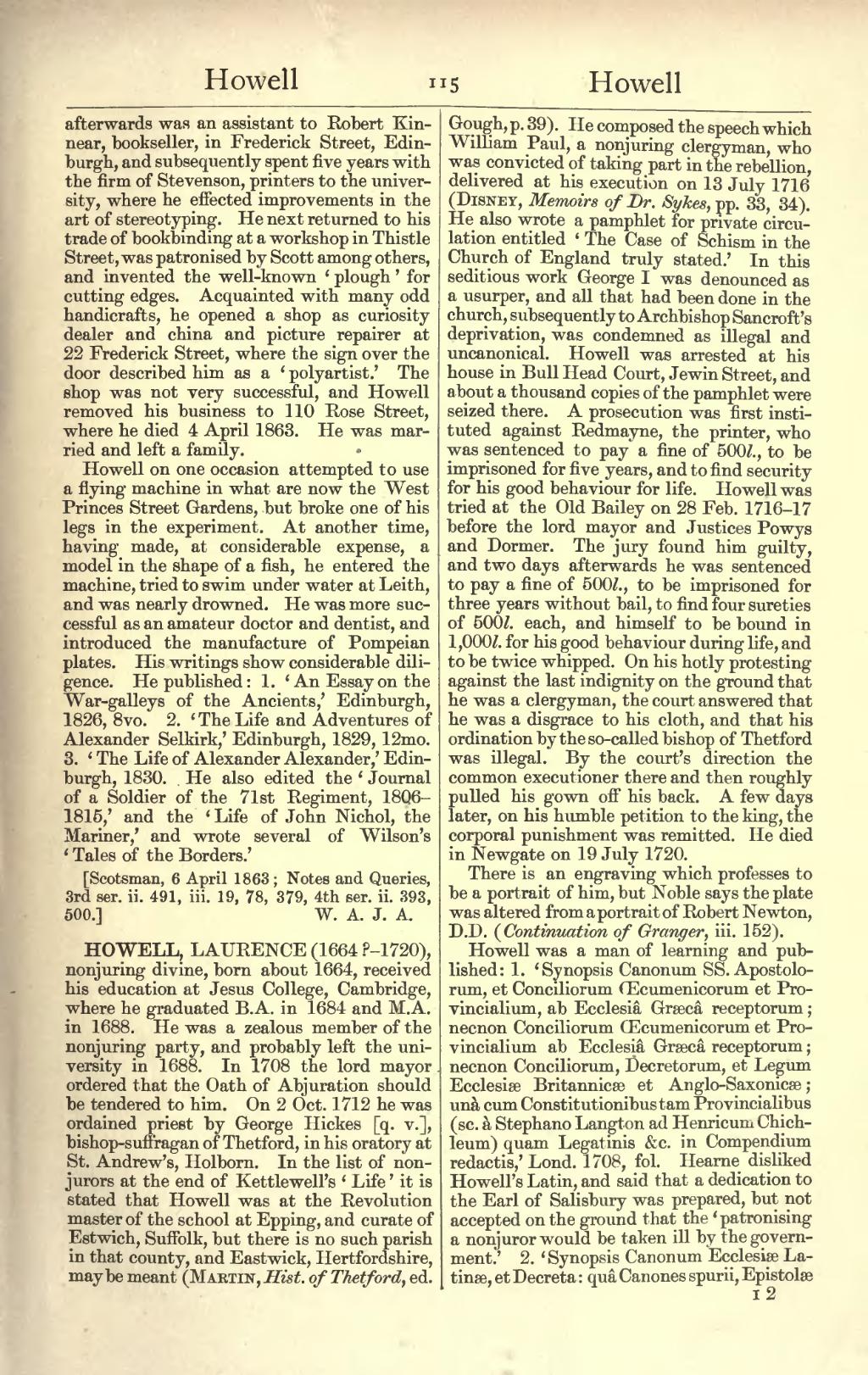afterwards was an assistant to Robert Kinnear, bookseller, in Frederick Street, Edinburgh, and subsequently spent five years with the firm of Stevenson, printers to the university, where he effected improvements in the art of stereotyping. He next returned to his trade of bookbinding at a workshop in Thistle Street, was patronised by Scott among others, and invented the well-known 'plough' for cutting edges. Acquainted with many odd handicrafts, he opened a shop as curiosity dealer and china and picture repairer at 22 Frederick Street, where the sign over the door described him as a 'polyartist.' The shop was not very successful, and Howell removed his business to 110 Rose Street, where he died 4 April 1863. He was married and left a family.
Howell on one occasion attempted to use a flying machine in what are now the West Princes Street Gardens, but broke one of his legs in the experiment. At another time, having made, at considerable expense, a model in the shape of a fish, he entered the machine, tried to swim under water at Leith, and was nearly drowned. He was more successful as an amateur doctor and dentist, and introduced the manufacture of Pompeian plates. His writings show considerable diligence. He published: 1. 'An Essay on the War-galleys of the Ancients,' Edinburgh, 1826, 8vo. 2. 'The Life and Adventures of Alexander Selkirk,' Edinburgh, 1829, 12mo. 3. 'The Life of Alexander Alexander,' Edinburgh, 1830. He also edited the 'Journal of a Soldier of the 71st Regiment, 1806-1815,' and the 'Life of John Nichol, the Mariner,' and wrote several of Wilson's 'Tales of the Borders.'
[Scotsman, 6 April 1863; Notes and Queries, 3rd ser. ii. 491, iii. 19, 78, 379, 4th ser. ii. 393, 500.]
HOWELL, LAURENCE (1664?–1720), nonjuring divine, born about 1664, received his education at Jesus College, Cambridge, where he graduated B.A. in 1684 and M.A. in 1688. He was a zealous member of the nonjuring party, and probably left the university in 1688. In 1708 the lord mayor ordered that the Oath of Abjuration should be tendered to him. On 2 Oct. 1712 he was ordained priest by George Hickes [q. v.], bishop-suffragan of Thetford, in his oratory at St. Andrew's, Holborn. In the list of nonjurors at the end of Kettlewell's 'Life' it is stated that Howell was at the Revolution master of the school at Epping, and curate of Estwich, Suffolk, but there is no such parish in that county, and Eastwick, Hertfordshire, may be meant (Martin, Hist. of Thetford, ed. Gough, p. 39). He composed the speech which William Paul, a nonjuring clergyman, who was convicted of taking part in the rebellion, delivered at his execution on 13 July 1716 (Disney, Memoirs of Dr. Sykes, pp. 33, 34). He also wrote a pamphlet for private circulation entitled `The Case of Schism in the Church of England truly stated.' In this seditious work George I was denounced as a usurper, and all that had been done in the church, subsequently to Archbishop Sancroft's deprivation, was condemned as illegal and uncanonical. Howell was arrested at his house in Bull Head Court, Jewin Street, and about a thousand copies of the pamphlet were seized there. A prosecution was first instituted against Redmayne, the printer, who was sentenced to pay a fine of 500l., to be imprisoned for five years, and to find security for his good behaviour for life. Howell was tried at the Old Bailey on 28 Feb. 1716-17 before the lord mayor and Justices Powys and Dormer. The jury found him guilty, and two days afterwards he was sentenced to pay a fine of 500l., to be imprisoned for three years without bail, to find four sureties of 500l. each, and himself to be bound in 1,000l. for his good behaviour during life, and to be twice whipped. On his hotly protesting against the last indignity on the ground that he was a clergyman, the court answered that he was a disgrace to his cloth, and that his ordination by the so-called bishop of Thetford was illegal. By the court's direction the common executioner there and then roughly pulled his gown off his back. A few days later, on his humble petition to the king, the corporal punishment was remitted. He died in Newgate on 19 July 1720.
There is an engraving which professes to be a portrait of him, but Noble says the plate was altered from a portrait of Robert Newton, D.D. (Continuation of Granger, iii. 152).
Howell was a man of learning and published: 1. 'Synopsis Canonum SS. Apostolorum, et Conciliorum (Ecumenicorum et Provincialium, ab Ecclesiâ Græcâ receptorum; necnon Conciliorum Œcumenicorum et Provincialium ab Ecclesiâ Græcâ receptorum; necnon Conciliorum, Decretorum, et Legum Ecclesiæ Britannicæ et Anglo-Saxonicæ; unà cum Constitutionibustam Provincialibus (sc. à Stephano Langton ad Henricum Chichleum) quam Legatinis &c. in Compendium redactis,' Lond. 1708, fol. Hearne disliked Howell's Latin, and said that a dedication to the Earl of Salisbury was prepared, but not accepted on the ground that the `patronising a nonjuror would be taken ill by the government.' 2. `Synopsis Canonum Ecclesiæ Latinæ, et Decreta: quâ Canones spurii, Epistolæ
i 2
